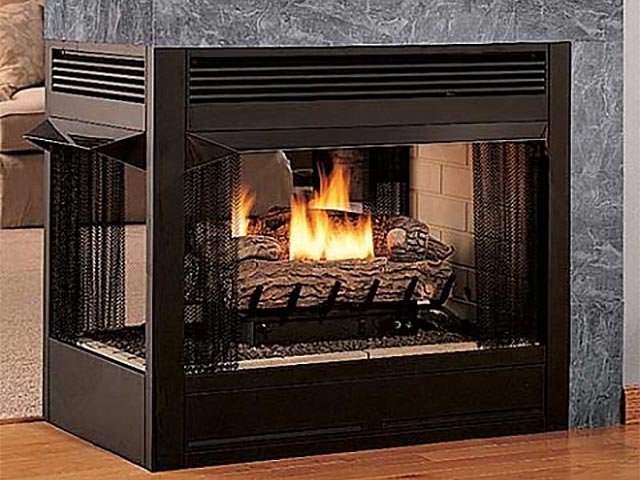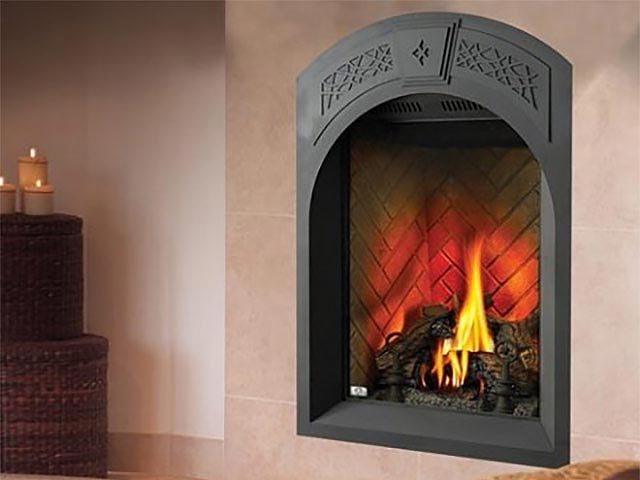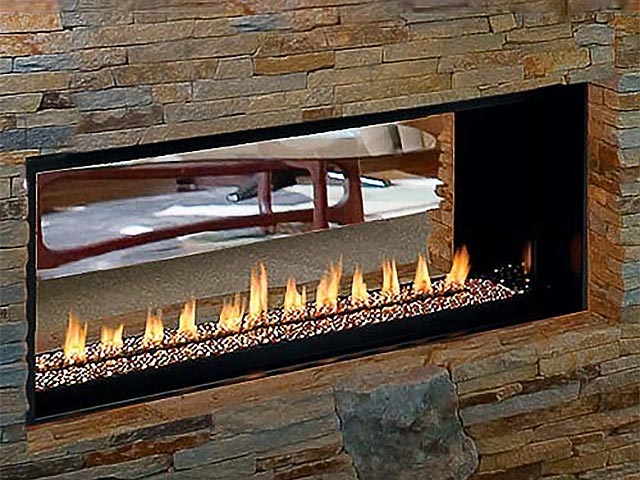Posted by Jeffrey Swerdan on Nov 9th 2023
Differences between B-Vent, Direct Vent, and Vent-Free gas heating appliances
Differences between B-Vent, Direct Vent, and Vent-Free gas fireplaces and heating appliances
If you are looking into adding a new heating appliance to your home, but you do not want to mess with the hassles of wood burning or if you are looking for a fireplace that can push more heat into your home, a gas heating appliance may be an ideal option. When looking through gas heating appliance options, it is easy to get overwhelmed by the multitude of venting options that are available. That is why we have put together this article to help you understand the differences so you can make an educated decision.
With natural gas and propane fireplaces and heaters, there are vented options as well as vent-free options to choose from
B-vent, Direct Vent, and Vent-Free represent three distinct types ofgas fireplaces and heating appliances, each with its unique characteristics and operation.
B-Vent, also known as Type B vent or natural draft vent, is commonly used for venting gas appliances that are designed to use indoor air for combustion. These appliances typically have a draft hood to facilitate the flow of air and exhaust gases. B-vent is used for Category I appliances, which are appliances that have a non-condensing flue gas temperature and rely on natural draft to expel combustion byproducts.
Here are some common types of gas appliances that use B-vent:
- Gas Fireplaces
- Gas Furnaces
- Gas Water Heaters
- Gas Boilers
Direct Vent appliances, on the other hand, operate by drawing air from the outdoors for combustion, thanks to a sealed glass front. They are designed to be more energy efficient and they also have sealed combustion systems. These appliances are often classified as Category IV appliances and use a two-pipe system for both fresh air intake and exhaust combustion by-products. This process helps maintain indoor air quality and greatly improves energy efficiency.
Here are some common types of gas appliances that use direct venting:
- Gas Fireplaces
- High-Efficiency Gas Furnaces
- High-Efficiency Gas Water Heaters
- Gas Stoves and cooktops
- Gas Boiler Systems
Vent-free or Ventless appliances, as the name suggests, are designed to operate without a traditional chimney or venting system to expel combustion byproducts. Instead, these appliances are designed to burn natural gas or propane efficiently and release the combustion gases directly into the living space where they are installed.
The two most common types of Vent-free appliances are:
Vent-free appliances feature an oxygen depletion sensor, often called an ODS, which is a safety sensor that monitors the level of oxygen in the room where the appliance is operating. If the oxygen concentration begins to drop below a safe level, the ODS will shut the gas supply to the unit off, which will also turn off the unit. This is a crucial safety feature for vent-free appliances because they release combustion byproducts, including carbon dioxide, water vapor, and small amounts of carbon monoxide, directly into the room.
Due to the nature of their operation, Vent Free Gas appliances are subject to strict installation requirements and regional restrictions due to safety concerns. There are some states and cities which do not allow Vent Free products to be installed. You will want to check with your state and local building codes to see if these are approved in your area.
Below is a quick comparison of B vent, Direct Vent, and Vent Free units:
- B-Vent units require venting and uses indoor air. The heat efficiency is medium and there are few installation restrictions.
- Direct Vent units require venting and does not use indoor air. The heat efficiency is high and there are few installation restrictions.
- Vent-Free units require do not require venting and the use of indoor air is non-applicable. The heat efficiency is maximum and there are many installation restrictions.
B-Vent indoor fireplaces are designed more for ambiance than to be used as a primary heating source
B-Vent natural gas and propane fireplaces are typically designed for aesthetics and ambiance rather than as a primary heating source. While they do produce heat, their efficiency is lower compared to other types of gas fireplaces. The efficiency ratings of B-vent fireplaces usually hover around 50-60%. The main reason for their lower efficiency is the use of indoor air for combustion, which also results in the loss of warm indoor air through the vent.
B-vent fireplaces are known for their traditional fireplace look and realistic flames. They can be a great addition to any room where you want to create a cozy atmosphere. Their venting system is relatively inexpensive and simple to install, but it requires a vertical installation through the interior of the house, terminating above the roof.
B-Vent fireplaces include features like:
- Realistic flames: The design of B-vent fireplaces often includes a log set to create the look of a real wood-burning fireplace
- Ease of use: B-vent fireplaces can be turned on or off quickly, making them convenient for occasional use
- Safety: These fireplaces vent combustion fumes outside, improving indoor air quality
However, it's worth noting that B-vents are not the best option when it comes to warming large spaces or for use as a primary heating source.
Unlike traditional wood-burning fireplaces, direct vent fireplaces have a sealed firebox but can produce more warmth and efficiency than the B Vent fireplaces
Direct vent fireplaces are known for their efficiency and heat output. This is mainly because they use outdoor air for combustion, preventing the loss of warm indoor air. The sealed combustion system also improves indoor air quality by eliminating any potential draft issues.
The sealed glass front of these fireplaces not only enhances safety but also contributes to their visually appealing design. This, coupled with their high heat output, makes them an ideal choice for homeowners seeking both functionality and aesthetic value.
However, it's important to note that the installation of a direct vent fireplace may be more complex and costly than that of a B-vent due to the need for a two-pipe system.
Here are some features of direct-vent fireplaces:
- Sealed combustion system
- Uses outdoor air for combustion
- High heat output
- Energy efficiency
- Improved indoor air quality
Direct vent fireplaces are an excellent choice for homeowners seeking a balance between efficiency, heat output, and aesthetic appeal. Direct vent fireplaces provide the warmth and ambiance of a traditional fireplace without the drawbacks associated with wood-burning fireplaces, such as soot, ash, and the need for a functioning chimney. They are also safer and more energy efficient than many ventless gas fireplaces.
Is Direct Vent piping the same as Class A vent pipe?
Direct vent double pipe systems are different than a double wall Class A style pipe. They serve different purposes and are designed for two different types of heating appliances. Direct Vent units require two separate pipes instead of two compartments housed in one pipe. Usually, the two pipes are installed close together.
Class A chimney pipe is designed for wood-burning or solid fuel-burning appliances, such as wood stoves, fireplaces, and some pellet stoves. It provides a venting solution for the exhaust gases produced during combustion. Class A chimney pipe is typically a double or a triple wall pipe system with an insulated interior that helps prevent excessive heat transfer to the exterior walls. It provides the necessary insulation and clearance requirements for safe chimney installations. Class A chimney pipe is built to withstand high temperatures generated by wood-burning appliances and is usually made of stainless steel or galvanized steel.
Direct vent piping is used for sealed combustion gas appliances, such as direct vent gas fireplaces, high-efficiency gas furnaces, and water heaters. These appliances have a sealed combustion chamber and draw in outside air for combustion, which is why they require a dedicated venting system. Direct vent piping typically consists of a double-pipe system, with one pipe bringing in outside combustion air and the other expelling combustion byproducts to the exterior. This system is often referred to as coaxial or concentric venting. Direct vent piping is usually constructed from materials suitable for indoor gas venting, such as aluminum, galvanized steel, or stainless steel.
Vent-free Fireplaces produce a superior amount of heat require no external venting and offer linear models and insert models as well
Vent-free fireplaces, also known as ventless fireplaces, are a popular choice due to their high heat output and minimal installation requirements. These units can produce a significant amount of heat, typically more than vented models, making them an excellent option for efficiently warming large spaces.
Unlike other types of gas fireplaces, vent-free units do not require a chimney or venting system. This eliminates the need for costly installation processes and allows for greater flexibility in placement. You can install these fireplaces virtually anywhere in your home, offering a unique blend of convenience and versatility.
Two popular types of vent-free fireplaces are:
- Linear models: These models have a modern and sleek design, often featuring a long, horizontal flame view. They can create a dramatic focal point in any room
- Insert models: These are designed to be installed into an existing fireplace cavity, providing an easy way to convert a traditional wood-burning fireplace into a more efficient and easy-to-use gas unit
Vent-free fireplaces are known for their high efficiency. They operate at near-perfect combustion rates, often exceeding 99%. This means almost all the heat produced is released into the room, maximizing their heating effectiveness. However, due to the fact that they release combustion byproducts into the home, they are equipped with safety features like an oxygen depletion sensor (ODS), which automatically shuts off the gas supply if oxygen levels drop below a safe level.
Please note, vent free products are subject to regional restrictions and installation requirements to ensure safety, so check your local building codes before purchasing.
Are vent-free fireplaces and vent-free heaters safe for use?
Vent Free gas heating appliances can be safe when installed and used correctly. As with any heating appliance, there are potential risks associated with the use of Vent-free appliances.
With Vent Free heating appliances combustion byproducts are released into the home. Small amounts of carbon monoxide and water vapors are released as the system is in operation. For some homeowners, they feel this affects the indoor air quality in the home. To mitigate these risks, these appliances come equipped with safety features such as an oxygen depletion sensor (ODS). This shuts off the gas supply if oxygen levels fall below a certain threshold, preventing dangerous situations from occurring.
It is important to check with your state and local guidelines before installing and to make sure that vent-free gas appliances are correctly sized for the space they are intended to heat. Adequate ventilation is crucial to ensure safe operation.
FAQ - B Vent, Direct Vent & Vent Free Heating Appliances
What does direct vent mean?
The term direct vent refers to a specific type of venting system used in gas fireplaces and gas heating appliances. It involves a double pipe system, where one pipe draws in fresh outdoor air for combustion, and another expels the combustion byproducts back outdoors. This system is entirely sealed, meaning it doesn't affect indoor air quality by drawing from or releasing into it. Instead, it operates independently by directly venting to the outdoors, hence the term 'direct vent'. This method of venting is highly efficient and minimizes heat loss. It can be done either horizontally through a wall or vertically through a roof, depending on the specific appliance and installation requirements.
Which is better a direct vent or vent-free gas fireplace?
When deciding between a direct vent fireplace and a vent-free gas fireplace it really is going to come down to your specific needs. Do you need a unit that can heat a significant area? Do you have the ability to run external venting? What units are approved in your area?
Direct vent fireplaces offer a balanced mix of efficiency and safety. They pull in air from outdoors for combustion, thus leaving indoor air quality intact. Plus, their sealed combustion system ensures no dangerous gases enter your living space. However, they require a specific venting system, which can add to the installation costs and limit placement options.
On the other hand, vent-free fireplaces provide superior heating efficiency, often exceeding 99%. They require no external venting, offering flexibility in placement and saving on installation costs. However, they release combustion byproducts into your home, which some homeowners feel affects the indoor air quality, and because of this vent free appliances are not approved for use in all areas.
How efficient are direct vent gas fireplaces?
Direct vent gas fireplaces are known for their impressive efficiency when compared to traditional wood-burning fireplaces or older-model gas fireplaces. In general, these fireplaces can achieve an average efficiency rate between 60-80%. The high efficiency is primarily due to their sealed combustion system, which draws in fresh air from the outdoors, mixes it with fuel (either natural gas or propane), and then ignites the mixture to produce heat. Their efficiency is typically measured in terms of their ability to convert the energy from the gas fuel into usable heat for the home.
The venting process in direct vent fireplaces also contributes to their efficiency. They operate with two vents: the inner vent pulls in fresh air from the outside for combustion, while the outer vent expels the combustion byproducts, effectively keeping your indoor air quality intact. Then these fireplaces are designed to distribute heat evenly throughout your living space, thereby maximizing their heating effectiveness as well.
How does a gas fireplace work?
A gas fireplace operates through a system that combines gas fuel (either natural gas, NG, or propane, LP) with air in a controlled environment. The combustion process begins when you turn on the fireplace and the gas control valve opens, allowing gas to flow into the burner. The pilot light, or ignition system, ignites the gas and air mixture and this is how the system creates a flame. On some ignition systems, you can adjust the height of the flame. Also on some gas fireplaces they have options where they can come with remote controls and some will also come with blower systems that help to push more heat into the room that houses the heating appliance.
How much are direct vent gas fireplaces?
The pricing on Direct Vent fireplaces varies depending on the size, style, and design that you choose. On the low end, they can start around a couple of thousand dollars and can go up and over ten thousand dollars depending on the accessories that you choose to go with it as well as the venting components that are required.
Here are some of theDirect Vent Fireplaces you can find on Northline Express.
How much are Vent free fireplaces and vent-free heaters?
Vent Free Gas Fireplaces will vary in price depending on the style, size, and design. There is also a wide variety of control and accessory options that affect the price as well. These systems can start under a thousand dollars and can go up to several thousand dollars.
Vent Free Gas Heaters have loads of different options from different manufacturers. These can start as low as a few hundred dollars and go up to several thousand. Not all heaters are created equal though. It is important to do some research on different brands and models to make sure that the unit you are choosing is right for the application you want to use it for.
Where can I go to learn more about gas fireplaces?
The Northline Express Resource Center is full of helpful articles and help pages to provide you with all the information you need on a variety of home heating projects.
- All About Type-B Gas Vent Fireplaces
- All About Direct Vent Gas Fireplaces
- All About Vent-Free Gas Fireplaces
- Tips on How to Choose the Right Gas-Fueled Fireplace

B-Vent
Sometimes referred to as Natural Vent - B-Vent appliances use pipe (b-vent) that must be installed through the home and terminate above the roof. They also use room air for combustion, but the amount of air they use is minimal.
Shop Now
Direct Vent
In direct-vent appliances, you use special direct-vent pipe recommended by the supplier. The direct-vent system involves two parts, one part for the exhaust and one for combustion air intake.
Shop Now
Vent-Free
Heatilator fireplaces are available in a variety of styles and various fuel options that appeal to every life style whether it be the simplicity of a gas or electric fireplace or the traditional appeal of a wood burning fireplace.
Shop Now
